Abstract
The functional control of problem behavior is generally conceptualized as involving attention, escape, sensory reinforcement, and tangible factors. Our analytic tools have now reached a level of sophistication that makes possible consideration of several new, emerging themes in the area of functional analysis. First, we need to examine other functional properties of problem behavior involving social avoidance, biological reinforcement, and respondent conditioning factors. Second, we need to explore the role of context, including social factors such as group interactions, sequencing of tasks and activities, presence or absence of specific individuals, and crowding; as well as biological factors, such as physical illness, exercise, and drugs. Finally, we must consider the multidimensional character of assessment in naturalistic settings and the practical need for developing descriptive analytic procedures that complement and produce results that are congruent with those obtained from traditional functional analyses.
Full text
PDF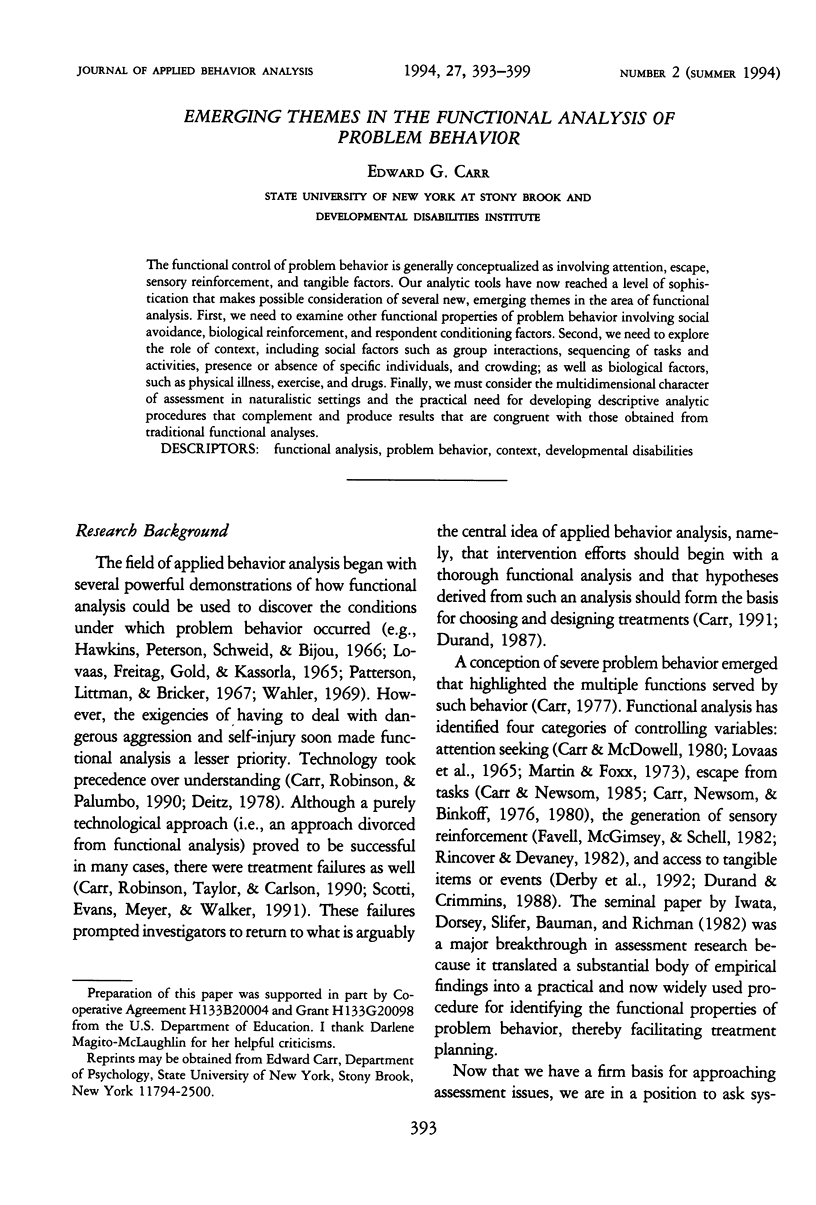
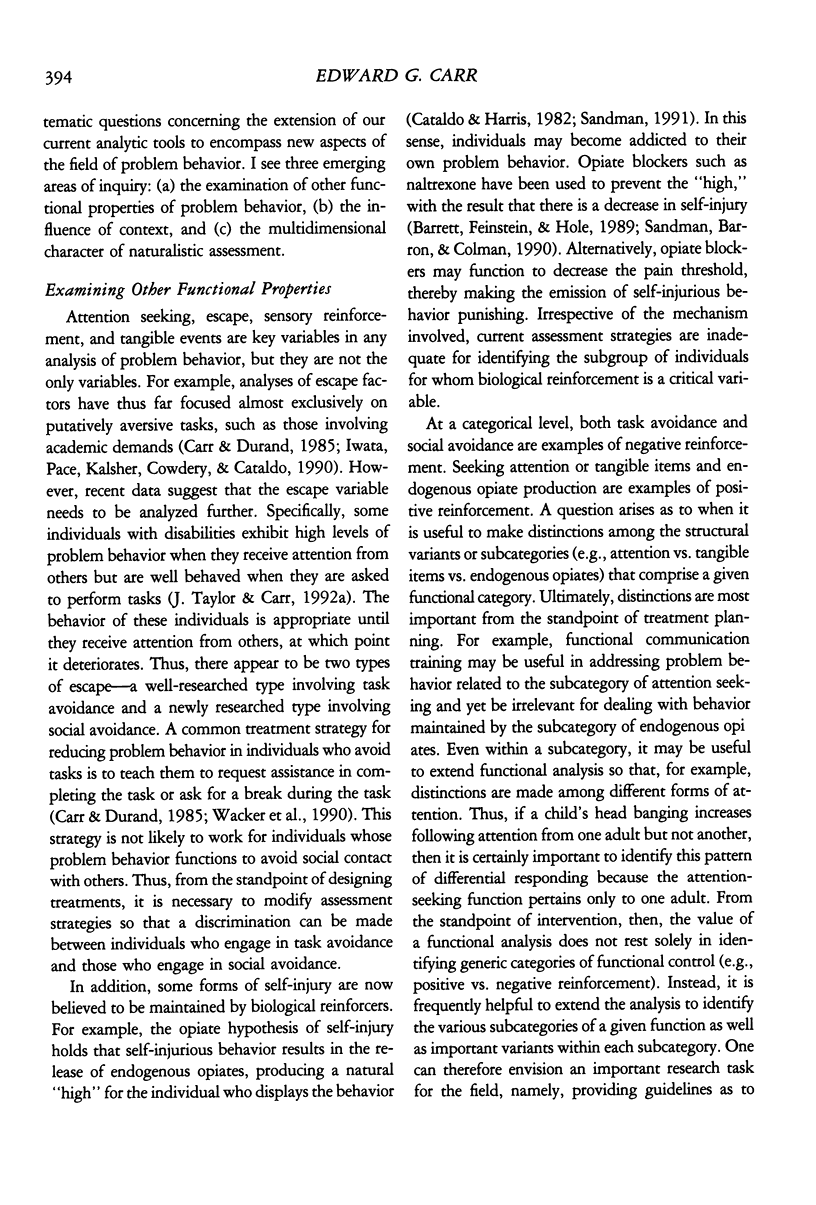
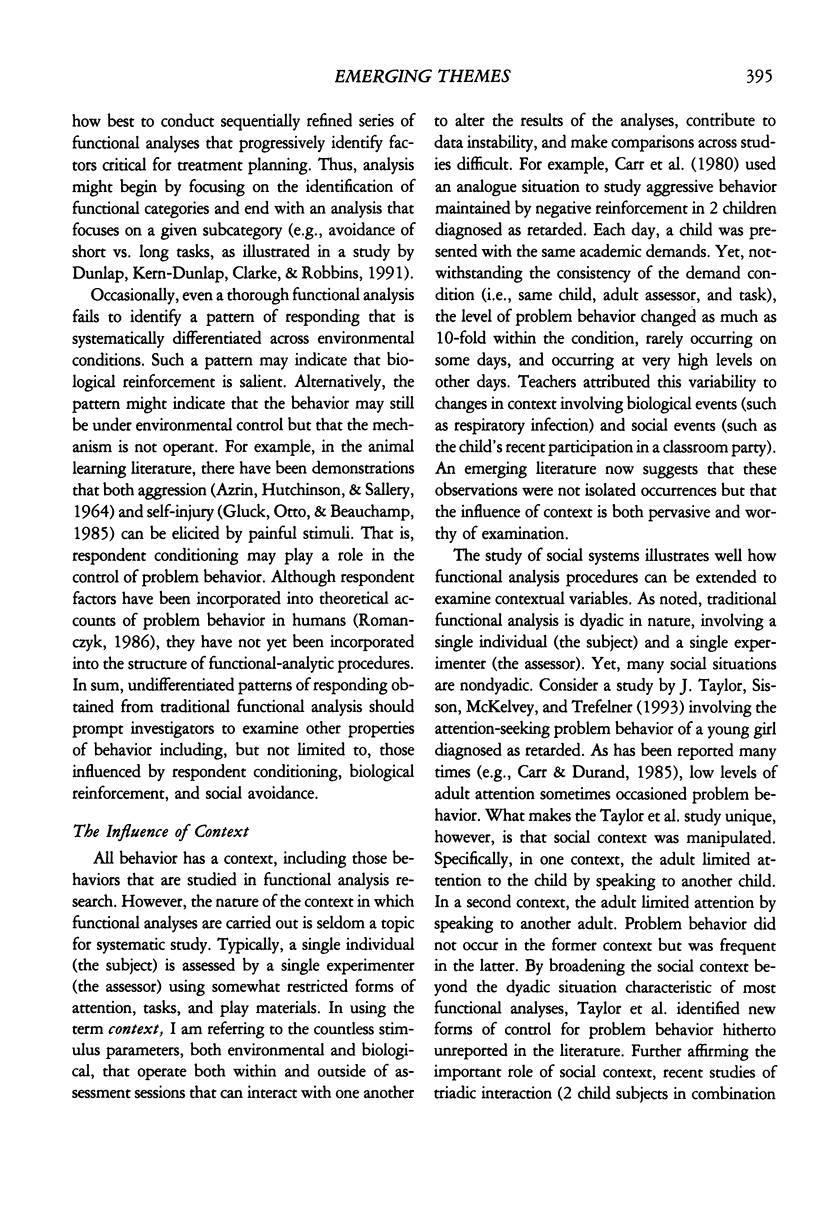
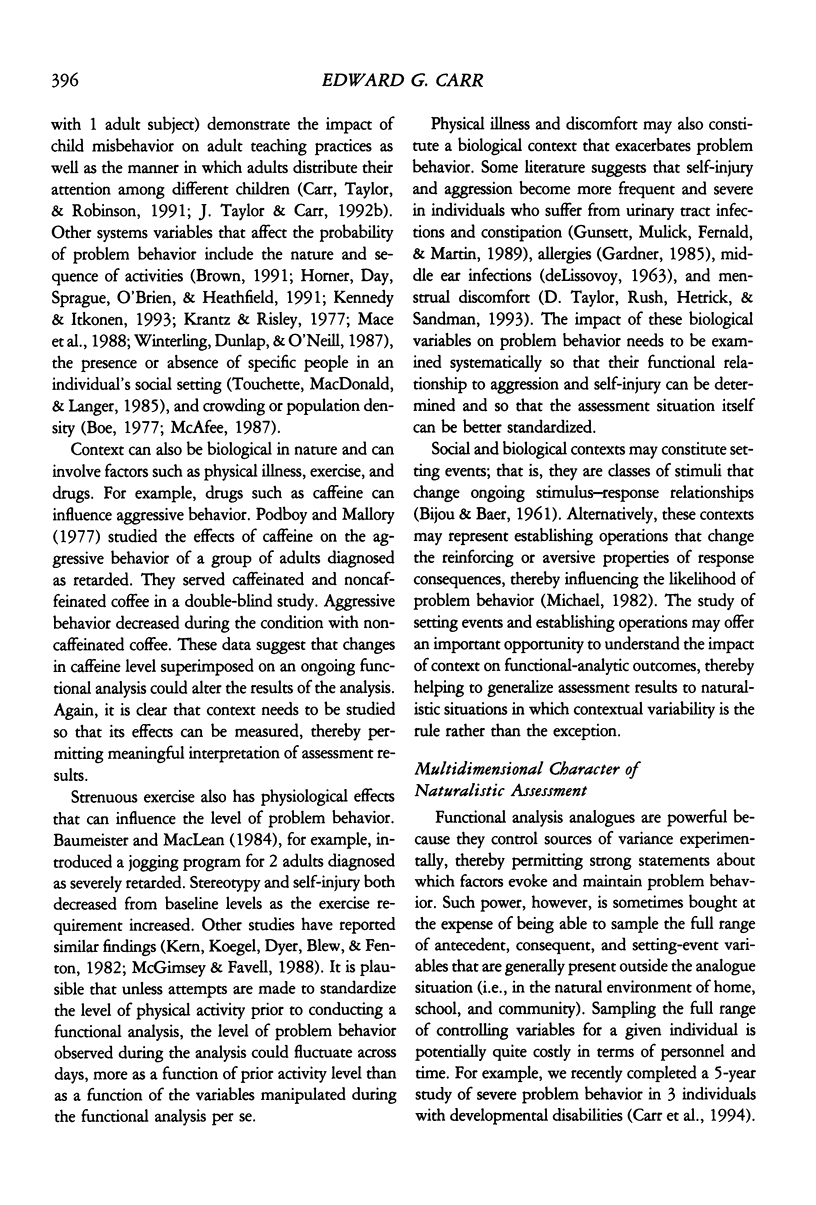
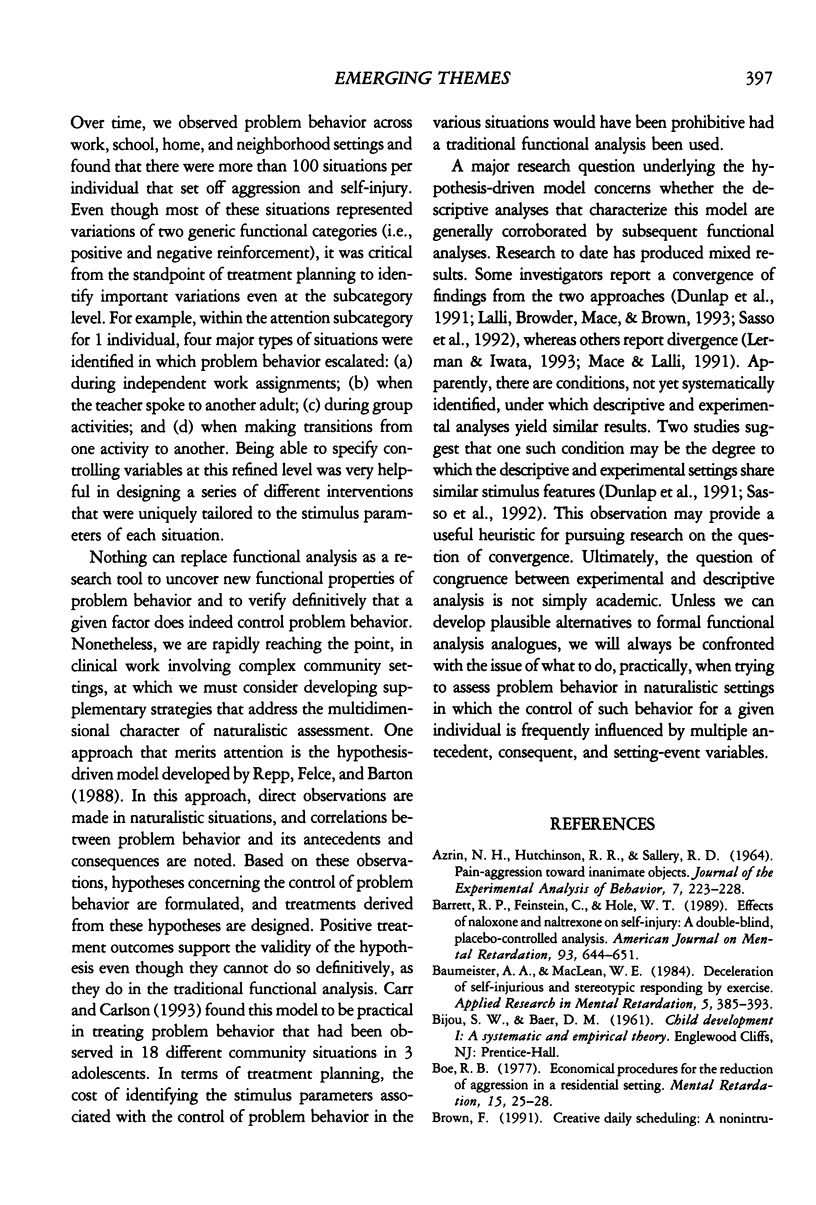
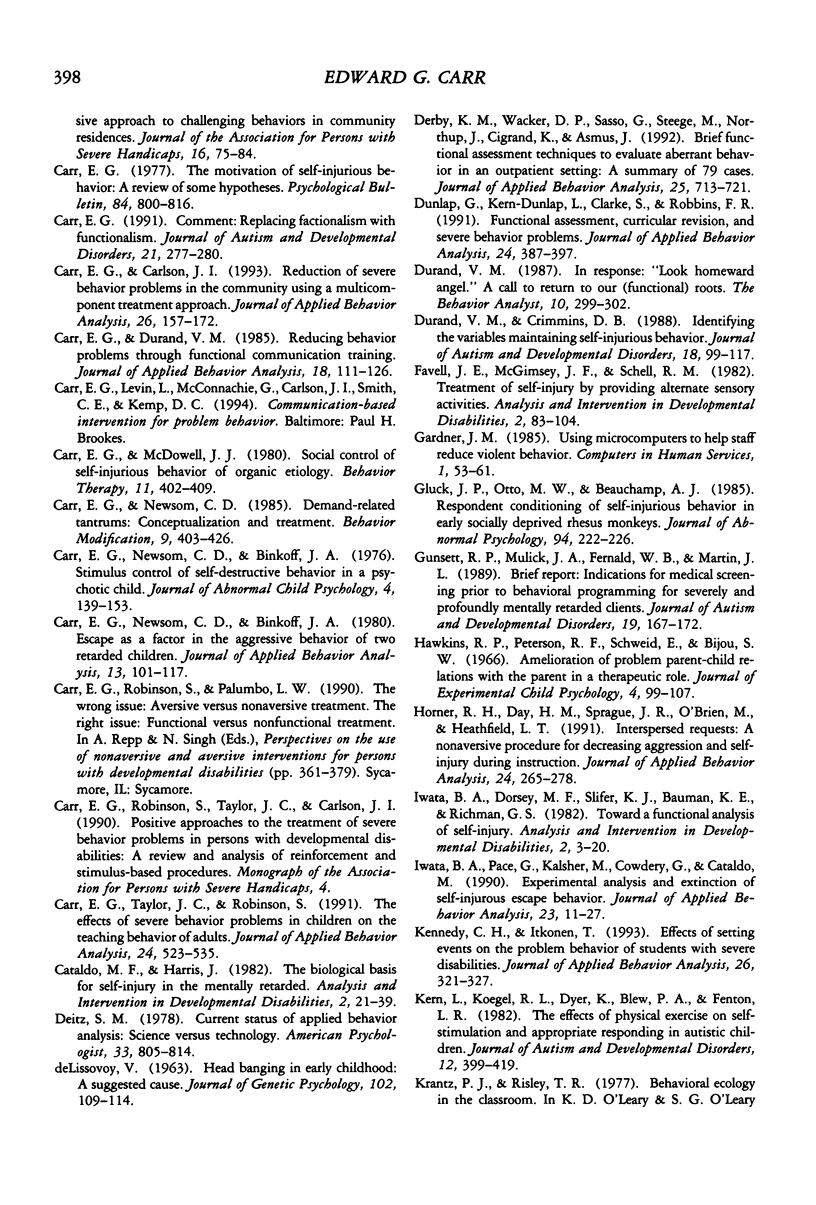
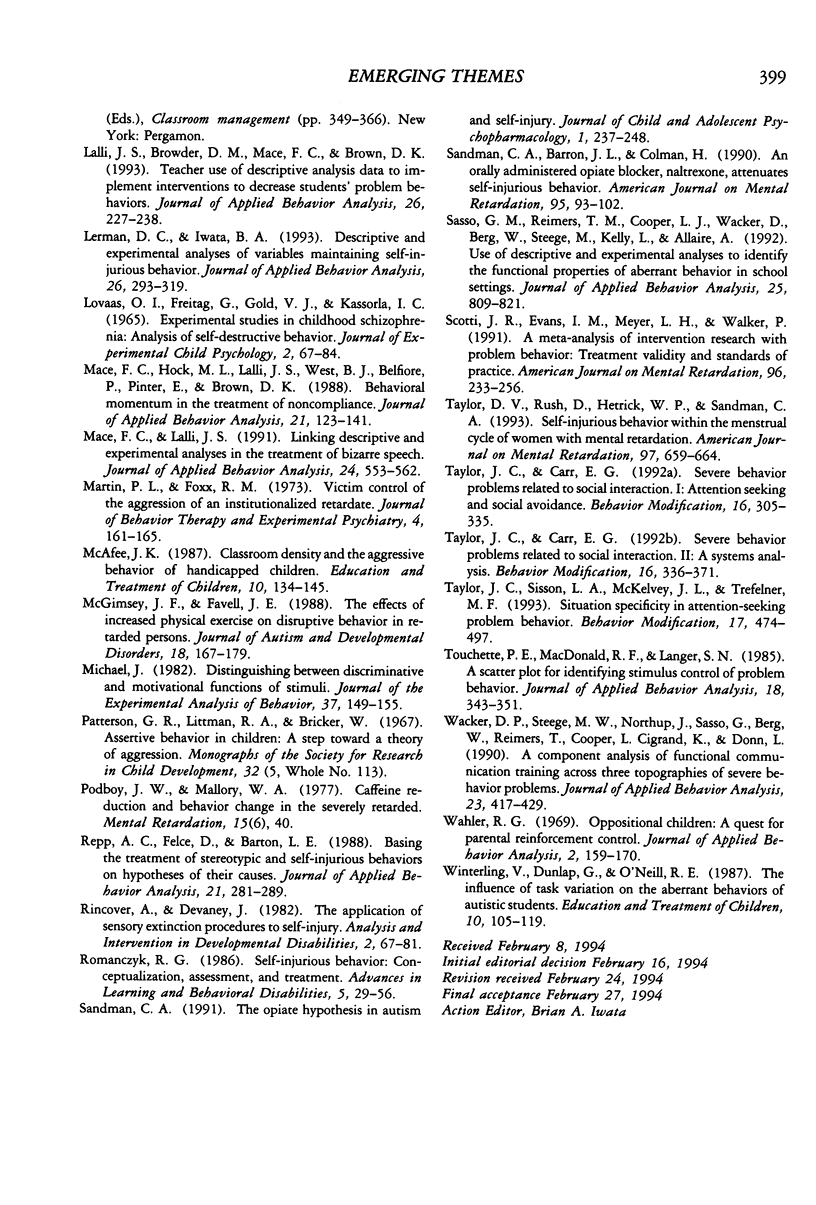
Selected References
These references are in PubMed. This may not be the complete list of references from this article.
- AZRIN N. H., HUTCHINSON R. R., SALLERY R. D. PAIN-AGGRESSION TOWARD INANIMATE OBJECTS. J Exp Anal Behav. 1964 May;7:223–228. doi: 10.1901/jeab.1964.7-223. [DOI] [PMC free article] [PubMed] [Google Scholar]
- Barrett R. P., Feinstein C., Hole W. T. Effects of naloxone and naltrexone on self-injury: a double-blind, placebo-controlled analysis. Am J Ment Retard. 1989 May;93(6):644–651. [PubMed] [Google Scholar]
- Baumeister A. A., MacLean W. E., Jr Deceleration of self-injurious and stereotypic responding by exercise. Appl Res Ment Retard. 1984;5(3):385–393. doi: 10.1016/s0270-3092(84)80059-4. [DOI] [PubMed] [Google Scholar]
- Boe R. B. Economical procedures for the reduction of aggression in a residential setting. Ment Retard. 1977 Oct;15(5):25–28. [PubMed] [Google Scholar]
- Carr E. G., Carlson J. I. Reduction of severe behavior problems in the community using a multicomponent treatment approach. J Appl Behav Anal. 1993 Summer;26(2):157–172. doi: 10.1901/jaba.1993.26-157. [DOI] [PMC free article] [PubMed] [Google Scholar]
- Carr E. G., Durand V. M. Reducing behavior problems through functional communication training. J Appl Behav Anal. 1985 Summer;18(2):111–126. doi: 10.1901/jaba.1985.18-111. [DOI] [PMC free article] [PubMed] [Google Scholar]
- Carr E. G., Newsom C. D., Binkoff J. A. Escape as a factor in the aggressive behavior of two retarded children. J Appl Behav Anal. 1980 Spring;13(1):101–117. doi: 10.1901/jaba.1980.13-101. [DOI] [PMC free article] [PubMed] [Google Scholar]
- Carr E. G., Newsom C. D., Binkoff J. A. Stimulus control of self-destructive behavior in a psychotic child. J Abnorm Child Psychol. 1976;4(2):139–153. doi: 10.1007/BF00916518. [DOI] [PubMed] [Google Scholar]
- Carr E. G., Newsom C. Demand-related tantrums. Conceptualization and treatment. Behav Modif. 1985 Oct;9(4):403–426. doi: 10.1177/01454455850094001. [DOI] [PubMed] [Google Scholar]
- Carr E. G., Taylor J. C., Robinson S. The effects of severe behavior problems in children on the teaching behavior of adults. J Appl Behav Anal. 1991 Fall;24(3):523–535. doi: 10.1901/jaba.1991.24-523. [DOI] [PMC free article] [PubMed] [Google Scholar]
- Carr E. G. The motivation of self-injurious behavior: a review of some hypotheses. Psychol Bull. 1977 Jul;84(4):800–816. [PubMed] [Google Scholar]
- DE LISSOVOY V. Head banging in early childhood: a suggested cause. J Genet Psychol. 1963 Mar;102:109–114. doi: 10.1080/00221325.1963.10532730. [DOI] [PubMed] [Google Scholar]
- Derby K. M., Wacker D. P., Sasso G., Steege M., Northup J., Cigrand K., Asmus J. Brief functional assessment techniques to evaluate aberrant behavior in an outpatient setting: a summary of 79 cases. J Appl Behav Anal. 1992 Fall;25(3):713–721. doi: 10.1901/jaba.1992.25-713. [DOI] [PMC free article] [PubMed] [Google Scholar]
- Dunlap G., Kern-Dunlap L., Clarke S., Robbins F. R. Functional assessment, curricular revision, and severe behavior problems. J Appl Behav Anal. 1991 Summer;24(2):387–397. doi: 10.1901/jaba.1991.24-387. [DOI] [PMC free article] [PubMed] [Google Scholar]
- Durand V. M., Crimmins D. B. Identifying the variables maintaining self-injurious behavior. J Autism Dev Disord. 1988 Mar;18(1):99–117. doi: 10.1007/BF02211821. [DOI] [PubMed] [Google Scholar]
- Gluck J. P., Otto M. W., Beauchamp A. J. Respondent conditioning of self-injurious behavior in early socially deprived rhesus monkeys (Macaca mulatta). J Abnorm Psychol. 1985 May;94(2):222–226. doi: 10.1037//0021-843x.94.2.222. [DOI] [PubMed] [Google Scholar]
- Gunsett R. P., Mulick J. A., Fernald W. B., Martin J. L. Indications for medical screening prior to behavioral programming for severely and profoundly mentally retarded clients. J Autism Dev Disord. 1989 Mar;19(1):167–172. doi: 10.1007/BF02212728. [DOI] [PubMed] [Google Scholar]
- Hawkins R. P., Peterson R. F., Schweid E., Bijou S. W. Behavior therapy in the home: amelioration of problem parent-child relations with the parent in a therapeutic role. J Exp Child Psychol. 1966 Sep;4(1):99–107. doi: 10.1016/0022-0965(66)90054-3. [DOI] [PubMed] [Google Scholar]
- Horner R. H., Day H. M., Sprague J. R., O'Brien M., Heathfield L. T. Interspersed requests: a nonaversive procedure for reducing aggression and self-injury during instruction. J Appl Behav Anal. 1991 Summer;24(2):265–278. doi: 10.1901/jaba.1991.24-265. [DOI] [PMC free article] [PubMed] [Google Scholar]
- Iwata B. A., Pace G. M., Kalsher M. J., Cowdery G. E., Cataldo M. F. Experimental analysis and extinction of self-injurious escape behavior. J Appl Behav Anal. 1990 Spring;23(1):11–27. doi: 10.1901/jaba.1990.23-11. [DOI] [PMC free article] [PubMed] [Google Scholar]
- Kennedy C. H., Itkonen T. Effects of setting events on the problem behavior of students with severe disabilities. J Appl Behav Anal. 1993 Fall;26(3):321–327. doi: 10.1901/jaba.1993.26-321. [DOI] [PMC free article] [PubMed] [Google Scholar]
- Kern L., Koegel R. L., Dyer K., Blew P. A., Fenton L. R. The effects of physical exercise on self-stimulation and appropriate responding in autistic children. J Autism Dev Disord. 1982 Dec;12(4):399–419. doi: 10.1007/BF01538327. [DOI] [PubMed] [Google Scholar]
- Lalli J. S., Browder D. M., Mace F. C., Brown D. K. Teacher use of descriptive analysis data to implement interventions to decrease students' problem behaviors. J Appl Behav Anal. 1993 Summer;26(2):227–238. doi: 10.1901/jaba.1993.26-227. [DOI] [PMC free article] [PubMed] [Google Scholar]
- Lerman D. C., Iwata B. A. Descriptive and experimental analyses of variables maintaining self-injurious behavior. J Appl Behav Anal. 1993 Fall;26(3):293–319. doi: 10.1901/jaba.1993.26-293. [DOI] [PMC free article] [PubMed] [Google Scholar]
- Mace F. C., Hock M. L., Lalli J. S., West B. J., Belfiore P., Pinter E., Brown D. K. Behavioral momentum in the treatment of noncompliance. J Appl Behav Anal. 1988 Summer;21(2):123–141. doi: 10.1901/jaba.1988.21-123. [DOI] [PMC free article] [PubMed] [Google Scholar]
- Mace F. C., Lalli J. S. Linking descriptive and experimental analyses in the treatment of bizarre speech. J Appl Behav Anal. 1991 Fall;24(3):553–562. doi: 10.1901/jaba.1991.24-553. [DOI] [PMC free article] [PubMed] [Google Scholar]
- McGimsey J. F., Favell J. E. The effects of increased physical exercise on disruptive behavior in retarded persons. J Autism Dev Disord. 1988 Jun;18(2):167–179. doi: 10.1007/BF02211944. [DOI] [PubMed] [Google Scholar]
- Michael J. Distinguishing between discriminative and motivational functions of stimuli. J Exp Anal Behav. 1982 Jan;37(1):149–155. doi: 10.1901/jeab.1982.37-149. [DOI] [PMC free article] [PubMed] [Google Scholar]
- Podboy J. W., Mallory W. A. Caffeine reduction and behavior change in the severely retarded. Ment Retard. 1977 Dec;15(6):40–40. [PubMed] [Google Scholar]
- Repp A. C., Felce D., Barton L. E. Basing the treatment of stereotypic and self-injurious behaviors on hypotheses of their causes. J Appl Behav Anal. 1988 Fall;21(3):281–289. doi: 10.1901/jaba.1988.21-281. [DOI] [PMC free article] [PubMed] [Google Scholar]
- Sandman C. A., Barron J. L., Colman H. An orally administered opiate blocker, naltrexone, attenuates self-injurious behavior. Am J Ment Retard. 1990 Jul;95(1):93–102. [PubMed] [Google Scholar]
- Sasso G. M., Reimers T. M., Cooper L. J., Wacker D., Berg W., Steege M., Kelly L., Allaire A. Use of descriptive and experimental analyses to identify the functional properties of aberrant behavior in school settings. J Appl Behav Anal. 1992 Winter;25(4):809–821. doi: 10.1901/jaba.1992.25-809. [DOI] [PMC free article] [PubMed] [Google Scholar]
- Scotti J. R., Evans I. M., Meyer L. H., Walker P. A meta-analysis of intervention research with problem behavior: treatment validity and standards of practice. Am J Ment Retard. 1991 Nov;96(3):233–256. [PubMed] [Google Scholar]
- Taylor D. V., Rush D., Hetrick W. P., Sandman C. A. Self-injurious behavior within the menstrual cycle of women with mental retardation. Am J Ment Retard. 1993 May;97(6):659–664. [PubMed] [Google Scholar]
- Taylor J. C., Carr E. G. Severe problem behaviors related to social interaction. 1: Attention seeking and social avoidance. Behav Modif. 1992 Jul;16(3):305–335. doi: 10.1177/01454455920163002. [DOI] [PubMed] [Google Scholar]
- Taylor J. C., Carr E. G. Severe problem behaviors related to social interaction. 2: A systems analysis. Behav Modif. 1992 Jul;16(3):336–371. doi: 10.1177/01454455920163003. [DOI] [PubMed] [Google Scholar]
- Taylor J. C., Sisson L. A., McKelvey J. L., Trefelner M. F. Situation specificity in attention-seeking problem behavior. A case study. Behav Modif. 1993 Oct;17(4):474–497. doi: 10.1177/01454455930174004. [DOI] [PubMed] [Google Scholar]
- Touchette P. E., MacDonald R. F., Langer S. N. A scatter plot for identifying stimulus control of problem behavior. J Appl Behav Anal. 1985 Winter;18(4):343–351. doi: 10.1901/jaba.1985.18-343. [DOI] [PMC free article] [PubMed] [Google Scholar]
- Wacker D. P., Steege M. W., Northup J., Sasso G., Berg W., Reimers T., Cooper L., Cigrand K., Donn L. A component analysis of functional communication training across three topographies of severe behavior problems. J Appl Behav Anal. 1990 Winter;23(4):417–429. doi: 10.1901/jaba.1990.23-417. [DOI] [PMC free article] [PubMed] [Google Scholar]
- Wahler R. G. Oppositional children: a quest for parental reinforcement control. J Appl Behav Anal. 1969 Fall;2(3):159–170. doi: 10.1901/jaba.1969.2-159. [DOI] [PMC free article] [PubMed] [Google Scholar]


